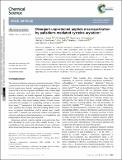Divergent unprotected peptide macrocyclisation by palladium-mediated cysteine arylation
Author(s)
Reilly, John; Rojas, Anthony Jose; Zhang, Chi; Vinogradova, Ekaterina V.; Buchwald, Nathan; Pentelute, Bradley L.; Buchwald, Stephen Leffler; ... Show more Show less
Downloadc6sc05454d.pdf (994.6Kb)
PUBLISHER_CC
Publisher with Creative Commons License
Creative Commons Attribution
Terms of use
Metadata
Show full item recordAbstract
Macrocyclic peptides are important therapeutic candidates due to their improved physicochemical properties in comparison to their linear counterparts. Here we detail a method for a divergent macrocyclisation of unprotected peptides by crosslinking two cysteine residues with bis-palladium organometallic reagents. These synthetic intermediates are prepared in a single step from commercially available aryl bis-halides. Two bioactive linear peptides with cysteine residues at i, i + 4 and i, i + 7 positions, respectively, were cyclised to introduce a diverse array of aryl and bi-aryl linkers. These two series of macrocyclic peptides displayed similar linker-dependent lipophilicity, phospholipid affinity, and unique volume of distributions. Additionally, one of the bioactive peptides showed target binding affinity that was predominantly affected by the length of the linker. Collectively, this divergent strategy allowed rapid and convenient access to various aryl linkers, enabling the systematic evaluation of the effect of appending unit on the medicinal properties of macrocyclic peptides.
Date issued
2016-12Department
Massachusetts Institute of Technology. Department of ChemistryJournal
Chemical Science
Publisher
Royal Society of Chemistry (RSC)
Citation
Rojas, Anthony J. et al. “Divergent Unprotected Peptide Macrocyclisation by Palladium-Mediated Cysteine Arylation.” Chemical Science 8, 6 (2017): 4257–4263 © 2017 The Royal Society of Chemistry
Version: Final published version
ISSN
2041-6520
2041-6539